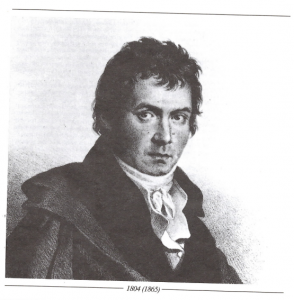Beethoven’s first two symphonies are mostly inheriting the form and style of classical era works. Indeed, many consider Beethoven as an innovator bridging classical and romantic times, and these two pieces reflected just that early phase of his long period of symphony works.

Beethoven in 1804 (from Beethoven 9 Symphonies by Karajan & BPO. DG-1963)
1. Adagio molto - Allegro con brio
First movement, as with all other movements in this symphony, is written in sonata form. The introduction, as most academia noted, is unusual in that it starts on woodwinds:
Theme 1:
Theme 2, first stated completely on woodwinds:
2. Andante cantabile con moto
The first theme has two parts, part A:
Part B:
The 2nd theme:
3. Menuetto: Allegro molto e vivace
The tempo used to play this movement, though marked as a Menuetto, is much faster and thus considered a Scherzo.
Theme 1:
Just like the first movement, theme 2 is again first stated by woodwinds led by oboe. This, plus the emphasis on woodwind in the symphony’s introduction, is considered a bold attempt of Beethoven to inject new ideas in classical symphonies:
4. Adagio - Allegro molto e vivace
The introduction of the finale is another unusual experiment at the time, with a strong chord followed by incremental fragments of the major scale, climbing close to the high octave before the main theme starts:
Theme 1:
Theme 2: